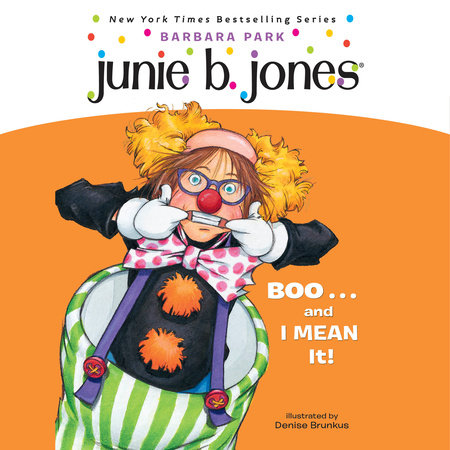TEACHING GUIDE
ABOUT THIS BOOKAbout the Junie B. Series and This Guide
The lovable, mischievous Junie B. of Barbara Park’s humorous series is growing up! She has graduated from kindergarten and moved up to the first grade. Follow Junie B. as she continues to get into one scrape after another. While laughing along with Junie and her friends, your students will expand their word recognition, develop a sense of story, and begin to read these early chapter books on their own.
In this guide for
Junie B., First Grade:, Boo . . . and I Mean It, Junie B. fans learn that what is a treat for some kids might feel like something quite different for others. A fun activity with pumpkins offers a cross-curricular opportunity to learn about this big orange fruit that is carved into scary jack-o-lanterns on Halloween. A bit of research on bats helps students to distinguish fact from fiction, and then create a poem for new bat lovers everywhere. And a hands-on activity creating clown faces provides the perfect context for practice with colors and shapes. Finally, a companion reproducible offers students the chance to help Junie find her way to her lost bag of trick-or-treat goodies.
TEACHING IDEASPre-Reading Activities
The kids in Junie B.’s first-grade class are looking forward to Halloween, but not Junie B. because she knows five scary secrets about that holiday that “take the brave right out of you.” Everyone is afraid of something, and it’s never polite to tease or tattle on someone’s fears. Junie B. says sometimes it makes you feel better to write down your fears or problems in a journal. Have students write an anonymous journal entry about their own fears on a slip of paper. Collect the papers and put them into a hat. Pick out one at a time and read out loud. Ask students offer advice as to how each fear might be overcome.
CLASSROOM CONNECTIONS
Pumpkin Fun! (Math, Science, History, Art)
Junie B. might have been less afraid of jack-o-lanterns with pointy teeth if she had known a little more about pumpkins. Using library or Internet resources (
www.urbanext.uiuc.edu/pumpkins/facts.html ), share some interesting facts about this large orange fruit, including where it originated and how it was used by Native Americans.
Bring a pumpkin into class. Slice off the top so students can see, touch, and smell the meat and seeds within. Discuss how the meat may be used in pies and the seeds roasted as snacks. Ask students to estimate the number of seeds in the pumpkin and record each student’s estimation on a list. Scoop out the seeds, and count the exact number. (This may also be done in small groups.) Compare estimations with the final count.
Spread seeds out on a cookie sheet and roast until golden brown. Dried seeds may be shared as a snack or glued onto an orange-colored paper plate with a green construction paper stem on top to create mosaic jack-o-lanterns for display.
Going Batty! (Science, Literature, Language Arts)
Junie B. worries that her Grandma Miller’s softie white hair will be the perfect home for a bat. Unfortunately, this concern and others are perpetuated by the many myths surrounding this flying mammal. Define
myth with your students. Ask students what they know about bats, listing everything they share on the blackboard. What stories have they read or heard about bats? How were the bats depicted? Are your students afraid of bats? Would they want one for a pet? Why not? What is it about the ways bats look and live that make them appear like evil and scary creatures?
Using library and Internet resources, research some common misconceptions about bats (
endangered.fws.gov/bats/miscon.htm). Armed with scientific knowledge, help
students distinguish the myths from the facts present in their lists. For example, “bats are blind” may be revised as “bats use echolocation to ‘see’ in the dark.” Identifying ways in which bats can actually be helpful to us can help students further appreciate these much- maligned creatures of the night.
Have students write a first-person poem entitled,
I Am a Bat, in which they express some of their true characteristics and their wish to be seen for what they truly are.
Clowning Around (Geometry, Art)
Squirty the Clown gave Junie B. bad dreams, but not all clowns are made up to be scary and mean. Ask students if they have ever seen clowns in a circus, a carnival, or a parade. What kinds of facial expressions did they have? Scary? Silly? Sad? Happy? How did they behave? Did they make them laugh or want to run away?
Making clown faces is a perfect opportunity to learn about shapes and to practice color recognition. Provide each student with a white paper plate and a selection of cutout construction paper geometric shapes in different sizes and colors. Be sure students are able to recognize and label circles, semi-circles, ovals, crescents, triangles, squares, and rectangles.
Allow each student to create a clown face, portraying their mood of choice, by selecting and gluing different geometric shapes for eyes, noses, etc. Don’t forget a shape for a hat and a shape for the hair. Have students glue a large craft stick or tongue depressor to the back of the plate and . . .
voila! Clown stick-puppets abound!
COPYRIGHTPrepared by Rosemary B. Stimola, Ph.D. She is a teacher of Children’s Literature at Hostos Community College/City University of New York and serves as educational and editorial consultant to publishers of children’s books.

